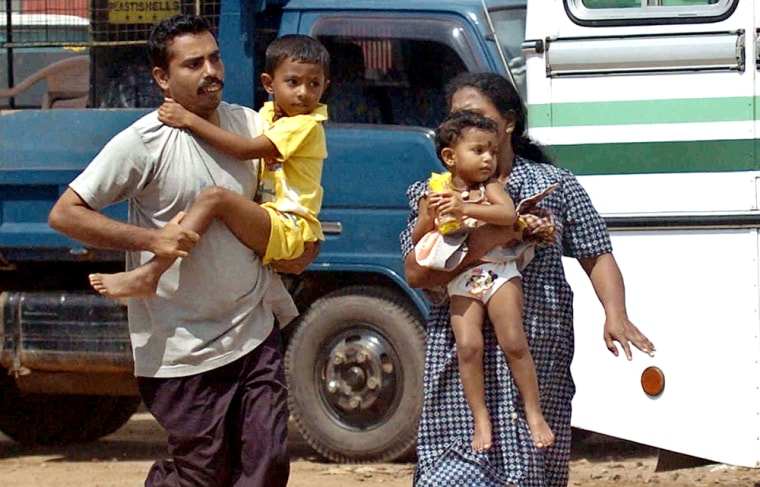Tens of thousands fled their homes Thursday, panicked by a false alarm that a new tsunami was about to hit following aftershocks in the Indian Ocean. India’s science minister blamed the confusion on information from an American research group.
Tsunami warnings went out in southern India, Thailand and Sri Lanka, where millions are still traumatized by last weekend’s devastating waves. India’s warning said the wave could hit within an hour — but hours later with no major waves, Science Minister Kapil Sibal said it was incorrect and dismissed fears of a new strike as “hogwash.”
By that time, thousands of people had made a desperate run for higher ground in southern Tamil Nadu state, where more than half of India’s 7,300 deaths Sunday occurred. Hundreds of refugees fled relief camps set up near the coastline, jostling to get into trucks and other vehicles, one police constable said.
‘We got into a truck and fled’
“We got into a truck and fled,” said Gandhimathi, who said authorities told her to leave her home, a mile from the beach in the town of Nagappattinam.
“We do not know where to go or where to spend the night. We took only a few clothes and left behind all of our belongings, everything we had. They do not know when we will be able to go back,” said the 40-year-old woman, who like many in the region uses only one name.
Police ordered hundreds of vehicles carrying relief supplies and rescue workers not to enter the town. Similar warnings were issued for India’s southern Kerala state and the Andaman and Nicobar islands.
The false alarm highlighted the lack of an organized tsunami warning system present in other parts of the world. Experts have said such a system would have helped save lives in Sunday’s disaster, in which a 9.0 magnitude quake off the coast of Sumatra sent 500 mph waves racing across the Indian Ocean, hitting unsuspecting residents thousands of miles away in Sri Lanka, India and East Africa.
The fears of a new tsunami were apparently sparked by a string of earthquakes in the past 24 hours, but an earthquake expert at the University of Hong Kong, Jason Ali, said they were around 1,000 times less powerful than Sunday’s and probably not big enough to produce tsunamis. “It’s probably going to have negligible impact,” he said.
An estimated 5.7 magnitude underwater earthquake was recorded early Thursday off northwest of Sumatra. Other new quakes were felt in Thailand and Myanmar. The U.S. Geological Survey also reported quakes ranging from 5.8 to 6.0 near India’s Nicobar islands about 16 hours earlier.
Oregon firm blamed
Sibal, India’s science minister, said the misinformation had come from a U.S. research group in Portland, Ore., called Terra Research. There is no telephone listing for Terra Research in Portland.
“(They) ... claimed they have some sensors and equipment through which they suggest there was a possibility of an earthquake,” Sibal said at a televised press conference. “So, on the basis of this communication, for anyone to reach a conclusion that a tsunami will hit the eastern coast of India is unscientific, hogwash and should be discarded.”
Tsunami sirens in southern Thailand sent people dashing from beaches, but only small waves followed the alarms.
Prime Minister Manmohan Singh, who was touring tsunami-hit areas Thursday, had planned to visit Nagappattinam later in the day but police said the visit would likely be canceled.
“It is doubtful. We are still undecided,” said police officer Manoharan.
In Sri Lanka, the military told residents of coastal areas not panic because of the alert, but the government advised them to move to higher ground as a precaution.
“We are asking residents to be alert and not to panic,” military spokesman, Brig. Daya Ratnayake said.
But Thilak Ranavirajah, the chief of Sri Lanka’s relief department, cautioned “all people along the coast to be vigilant and move to safer places.” A fire engine fitted with loudspeakers told residents to leave Tangalle, on the southern coast. “There is no reason to panic,” an official in the back of a jeep said through a megaphone. “You can go back to your jobs or your home, wherever you please. There is no imminent danger.”
Panic also was fueled by one television station that reported a tsunami had hit and showed file footage of large waves.
